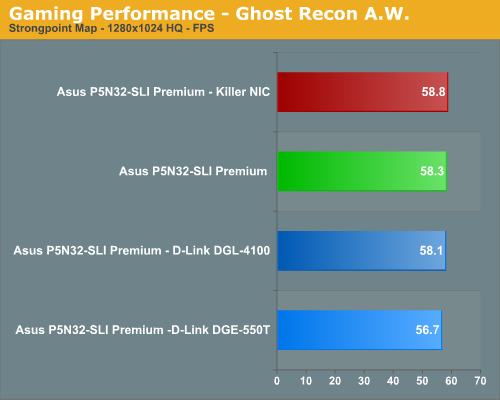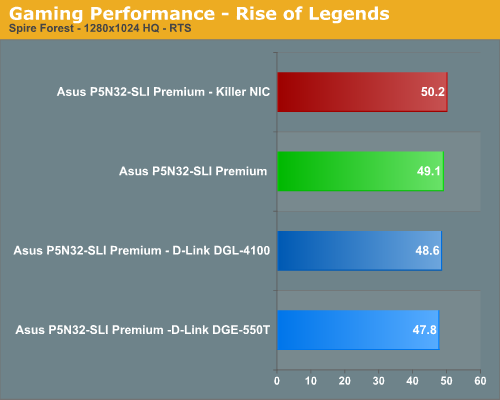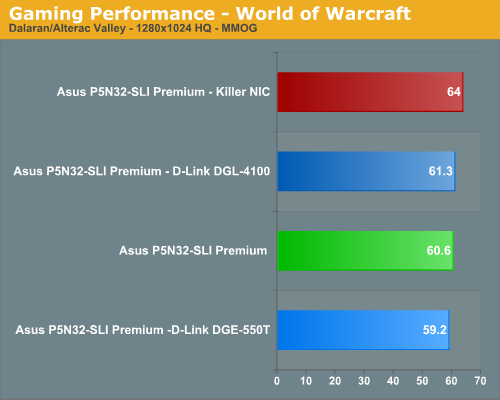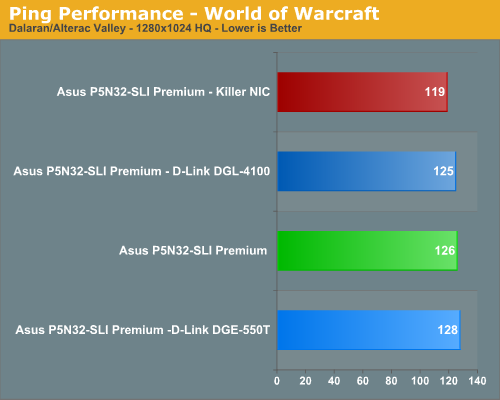BigFoot Networks Killer NIC: Killer Marketing or Killer Product?
by Gary Key on October 31, 2006 2:00 AM EST- Posted in
- Networking
Ghost Recon: Advanced Warfighter
While not the most popular online shooter this game has picked up steam lately with the 1.3 patch. We are playing on the Strongpoint map with a total of 12 players. Our video resolution is at 1280x1024 HQ and we found this game to be very playable at frame rates above 40 fps. The servers we connected with were generally showing ping rates around 45ms to 60ms at the time of connection.

We see a very slight frame rate improvement in this game but nothing that was noticeable during game play. It was difficult to tell any differences in game play between each product and as far as we could tell all systems played the game in a similar manner. If we had to make a choice we would choose the NVIDIA nForce 590SLI NIC as it seemed a tad bit smoother in certain areas.
Company of Heroes
Company of Heroes is one of our favorite RTS games around the office. We are playing the Lorraine map in one versus one player mode. Our other test party hosted the game and we found their system configuration to be nearly identical to ours. Our resolution was set to 1280x1024 with all options on high except for AA. This game is very playable with frame rates above 35 fps in multiplayer action.

Bigfoot Networks stated to us early on not to expect any measureable performance differences in the majority of RTS games. Sure enough we did not see any improvements although the Killer NIC did score a little higher than our D-Link solutions. Once again, we did not notice any real differences in game play between any of the products. We actually tried the Killer NIC in APP mode and were greeted with basically the same level of performance.
Rise of Legends
This game was released a few months back and like most real time strategy games is very CPU intensive but still offers a very visual experience. In order to experience the game properly you need a fast CPU, very good memory subsystem, and a decent GPU to play at the higher resolutions. This is one game that seems to have the perfect recipe for the Killer NIC. We are playing the Spire Forest map with Vinci versus Vinci. We generally found the game to be enjoyable with an average frame rate above 40 fps.

Although BigFoot Networks had stated most RTS games will not show any improvements we see a slight increase in frame rates with this game. We have to temper our results with the fact that there was not any noticeable difference in game play between the various products once again. In a blind performance test, any setup could have won for the most enjoyable game play experience.
World of WarCraft
WoW is the largest and probably most enjoyable MMO we have played and is a favorite amongst many of our staff members. This is another title that BigFoot Networks has explicitly stated will show performance improvements and is one that is mentioned in most of their marketing materials. We logged in at several different times that range from Wednesday morning to late night Saturdays to ensure we experienced a wide variety and number of players on the server. We started in the Dalaran Ruins and traveled to the Alterac Valley battlegrounds doing our best to battle the same creatures with each character.


We see about a 4% increase over our other products in frame rates. WoW is basically capped at 64 fps with dual core systems so it is difficult to determine if the Killer NIC would provide any further frame rate increases with our test platform. We have seen increases quoted in the 10% or plus range in this game so we utilized a 3.4GHz P4 in our test bed and noted a 9% increase in frame rates. The Killer NIC gets a point for increasing frame rates as advertised. Of course anything over 35 fps in this game is very playable so the increases while nice did not really improve our game play.
Ping rates did improve by up to 7% (host system improvements and server variables) and this is where we did notice a difference in game play during the busy test sessions on Friday and Saturday nights. When our area was full of players we did notice smoother game play at times with the Killer NIC. This did not happen when we were basically the only characters playing in certain sections. This game is designed to a certain degree for higher ping rates so there is some balancing that is already done by the server during combat. Overall, the Killer NIC performed almost as advertised in this benchmark.
In order to make sure we were not drinking the Snake Oil we did a blind performance test in WoW with a third party. The third party had no idea their on-board NIC had been replaced with the Killer NIC. The first reaction was a question asking if an additional one gigabyte of RAM had been added to the system or if the video card had been changed. This would normally make for very good publicity and we found it slightly amazing that someone would pick up on the differences in performance so quickly. However, this configuration was a dual core CPU based mid-range system and the user would not be one to spend $279.99 on a peripheral other than a new graphics card. If someone had offered them this card for $50 in order to improve their WoW experience they probably would have jumped at it instead of gasping when told the actual price.
While not the most popular online shooter this game has picked up steam lately with the 1.3 patch. We are playing on the Strongpoint map with a total of 12 players. Our video resolution is at 1280x1024 HQ and we found this game to be very playable at frame rates above 40 fps. The servers we connected with were generally showing ping rates around 45ms to 60ms at the time of connection.

We see a very slight frame rate improvement in this game but nothing that was noticeable during game play. It was difficult to tell any differences in game play between each product and as far as we could tell all systems played the game in a similar manner. If we had to make a choice we would choose the NVIDIA nForce 590SLI NIC as it seemed a tad bit smoother in certain areas.
Company of Heroes
Company of Heroes is one of our favorite RTS games around the office. We are playing the Lorraine map in one versus one player mode. Our other test party hosted the game and we found their system configuration to be nearly identical to ours. Our resolution was set to 1280x1024 with all options on high except for AA. This game is very playable with frame rates above 35 fps in multiplayer action.

Bigfoot Networks stated to us early on not to expect any measureable performance differences in the majority of RTS games. Sure enough we did not see any improvements although the Killer NIC did score a little higher than our D-Link solutions. Once again, we did not notice any real differences in game play between any of the products. We actually tried the Killer NIC in APP mode and were greeted with basically the same level of performance.
Rise of Legends
This game was released a few months back and like most real time strategy games is very CPU intensive but still offers a very visual experience. In order to experience the game properly you need a fast CPU, very good memory subsystem, and a decent GPU to play at the higher resolutions. This is one game that seems to have the perfect recipe for the Killer NIC. We are playing the Spire Forest map with Vinci versus Vinci. We generally found the game to be enjoyable with an average frame rate above 40 fps.

Although BigFoot Networks had stated most RTS games will not show any improvements we see a slight increase in frame rates with this game. We have to temper our results with the fact that there was not any noticeable difference in game play between the various products once again. In a blind performance test, any setup could have won for the most enjoyable game play experience.
World of WarCraft
WoW is the largest and probably most enjoyable MMO we have played and is a favorite amongst many of our staff members. This is another title that BigFoot Networks has explicitly stated will show performance improvements and is one that is mentioned in most of their marketing materials. We logged in at several different times that range from Wednesday morning to late night Saturdays to ensure we experienced a wide variety and number of players on the server. We started in the Dalaran Ruins and traveled to the Alterac Valley battlegrounds doing our best to battle the same creatures with each character.


We see about a 4% increase over our other products in frame rates. WoW is basically capped at 64 fps with dual core systems so it is difficult to determine if the Killer NIC would provide any further frame rate increases with our test platform. We have seen increases quoted in the 10% or plus range in this game so we utilized a 3.4GHz P4 in our test bed and noted a 9% increase in frame rates. The Killer NIC gets a point for increasing frame rates as advertised. Of course anything over 35 fps in this game is very playable so the increases while nice did not really improve our game play.
Ping rates did improve by up to 7% (host system improvements and server variables) and this is where we did notice a difference in game play during the busy test sessions on Friday and Saturday nights. When our area was full of players we did notice smoother game play at times with the Killer NIC. This did not happen when we were basically the only characters playing in certain sections. This game is designed to a certain degree for higher ping rates so there is some balancing that is already done by the server during combat. Overall, the Killer NIC performed almost as advertised in this benchmark.
In order to make sure we were not drinking the Snake Oil we did a blind performance test in WoW with a third party. The third party had no idea their on-board NIC had been replaced with the Killer NIC. The first reaction was a question asking if an additional one gigabyte of RAM had been added to the system or if the video card had been changed. This would normally make for very good publicity and we found it slightly amazing that someone would pick up on the differences in performance so quickly. However, this configuration was a dual core CPU based mid-range system and the user would not be one to spend $279.99 on a peripheral other than a new graphics card. If someone had offered them this card for $50 in order to improve their WoW experience they probably would have jumped at it instead of gasping when told the actual price.










87 Comments
View All Comments
Gary Key - Wednesday, November 1, 2006 - link
We tested these two cards as part of our Killer NIC testing routine. We did not report the numbers as they did not vary greatly from the NIVIDA 590SLI NIC solution.Crassus - Wednesday, November 1, 2006 - link
Sorry, but that plus the server test would have been very useful information I would have liked in the review. Or maybe we can have a different review, sort of a "NIC roundup". If your results are the same across the board, it's a finding worth mentioning as well, isn't it?Frumious1 - Tuesday, October 31, 2006 - link
I bet it doesn't even beat the onboard NVIDIA NIC. Or rather, it will tie the NVIDIA solution, which means it's equal to the Killer in most situations and fractionally slower in a few games. Maybe it has lower CPU usage when doing gigabit transmits, but high bandwidth with low CPU usage isn't going to matter much for gaming. Not that any NIC related stuff matters much for gaming these days.vaystrem - Tuesday, October 31, 2006 - link
I agree its very difficult to test NIC performance and kudos to Anandtech for trying. But, it seems to me that using the card as a server for the games where it saw the most improvement, Fear/CS, and even for those that it didn't may be more enlightening than exploring the client side of things.Gary Key - Tuesday, October 31, 2006 - link
We set up one of our test beds as a server for a couple of the games we tested. The performance was actually worse than our NVIDIA NIC (dualnet/teaming), Intel PRO/1000 PT, and barely did better than our D-Link PCI NIC in half of the tests. We will not fault the card for its peformance since it was specifically designed as a client side card. This very well could change in the future due to their ability to optimize driver code on the FPGA unit. The article could have gone another five pages with the server and LAN tests that we completed (neither showed any significant differences). It appears from several of the comments that anything over three pages was a waste anyway. ;-)EODetroit - Tuesday, October 31, 2006 - link
Except according to the PR material the card is made for game clients, not optimized for game servers.VooDooAddict - Tuesday, October 31, 2006 - link
While the POSIBILITY of embeded linux apps is interesting. For someone who would have the $$ do buy this ... they would have the money to put inexpensive PC parts together into a linux machine. Likely they have spare parts leftover from thier last upgrade.Anyone else think the company name is strangly fitting? "BigFoot" ... Myth and Hype?
Certainly not saying a nice NIC isnt'a good investment ... but at almost $300 ... it's a joke. Drop the embedded linux, hit the $50 price point and this thing would probably sell like mad to WoW Addicts. (eventually also have a PCIe version)
The aegia(sp?) physics processor is the same way. Great concept, but the tangable benefits are so minimal for the price. $300 Video cards took off because there was a tangable benefit.
Dropping anothre $300 into the Storage System, Monitor, CPU, Video card, RAM, or even Audio system (surround speakers) would give one a much mroe imersive experience.
Someone made the wrong decission to stick with the embedded linux thing. Seriously a sperate leftover parts Linux box and a DLINK 4100 router would be a far better way to go.
So any guesses as to the next $300 (*caugh* gimic *caugh*) expendature to "improve" gaming?
For those comparing this to SLI/Crossfire. SLI and Crossfire can offer substantial image quality enhancements for people with large pixel count LCDs. The ability to run LCDs at native resolution for gaming is a very tangable benefit. Not something everyone agrees it worth the $$. But the benefit is there.
VooDooAddict - Tuesday, October 31, 2006 - link
I was really hoping for somethign major from this card ... just from the perspective of reliving history.Around 10 years ago now (back around '96-'97) when NICs weren't build onboard spending $60-$70 on a 3Com 3c905 or a server class Intel NIC would make a bug differance in overall system performace when working with the Internet, LAN, and Gaming. They gave me big advantages over anyone who just went out an bought a cheapo $20 NE2000 comptable NIC (16-bit ISA even!).
I'm talking Quake 1, Duke3D, Quake 2, Quake CTF, Original Unreal... A single 3dFx VooDooGraphics Board + 3c905 = pwnage (back when "pwnage" was still a typo). I was so often accused of cheating by laptop wielding, software emulating, newbies (wasn't spelt "noob" then).
... That above is why I picked up the handle "VooDooAddict"
EODetroit - Tuesday, October 31, 2006 - link
And they deleted it. Claiming it needed to be moved from "Testimonials" to "General" forum. Whatever, but they didn't actually move my post, they deleted it and replaced it with a post of their own, with the link, plus quoted all the good things said in the Anandtech review and none of the bad. Typical and misleading, but hey, its their web site. They can do what they want. Still, misleading people doesn't endear them to anyone.LoneWolf15 - Tuesday, October 31, 2006 - link
I admire the amount of engineering that went into this product. It's obvious that the product isn't "snake oil" in the same way that, say, SoftRAM software was back in the day. There's a lot more to this card than just a NIC.That said, I don't think it provides enough benefit to justify $279 (unless perhaps you're making $50k+ a year in the PGL). Today's NICs are already pretty well optimized for most situations, plus many mainboard NICS are directly on the PCIe bus, something the Killer NIC can't offer (and as someone pointed out, try doing gig ethernet across a PCI slot; it really isn't feasible, especially if you already have the PCI bus shared with other components like a TV tuner or sound card). The Killer NIC's most interesting feature, FNApps, is not useful at the moment, and I'm still concerned that it might pose a security risk through a malformed application (that's assuming someone coded that app in the first place, considering how little marketshare the Killer NIC is likely to have). Like the Ageia PhysX, at this point in time, I don't see the justification.
P.S. Is it just me, or does the heatsink "K" look like a Klingon weapon? I'm thinking either Klingon brass-knuckles or a hybrid bat-lef. ;)